It is the Closest We Will Be
September 21- October 7, 2023
Liza Sokolovskaya’s first solo exhibition, It is the Closest We Will Be, is a humorous and poignant exploration of materials and memories, featuring oil paintings, textile works, acrylic skins, small sculptures, and papier maché objects. The concept for the installation is an artist’s live-work studio, the environment filled with images, detritus, and treasures from Sokolovskaya’s life, sometimes autobiographical, and at other times fictional. The works in this show are strongly suggestive of the idiosyncrasies of memory, its permeability, the way it fades and is distorted. Certain things, people, places, and questions haunt us. The show is focused on Sokolovskaya’s experience as an immigrant and her migratory life, travelling from Uzbekistan to Montreal, to New York, and then returning home. This show is a sort of homecoming as she was raised in Montreal, but left for several years to study in New York City. Sokolovskaya was born in 1989 in Tashkent, Uzbekistan, and her family immigrated to Montreal when she was a child.
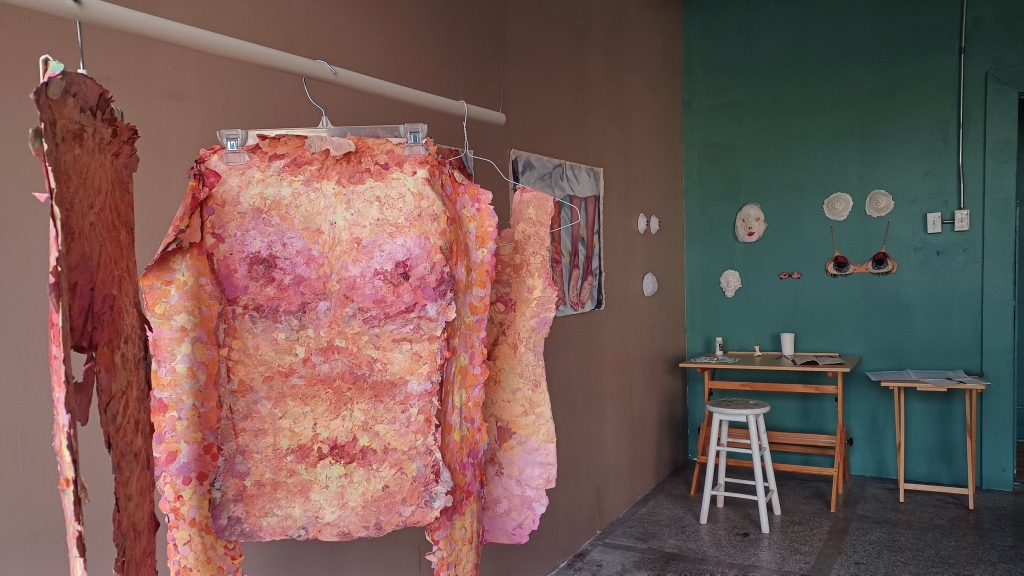
Sokolovskaya moved to New York City in 2016 when she began studying at the New York Academy of Art. NYAA has an esteemed MFA program, and is known for classes which focuses on technique and working from live models. After graduating, Sokolovskaya maintained a strong studio practice, during which she has explored painting pleinair painting, oil painting on mylar, textile art, making shaving cream monotypes, and more. Her experience at the prestigious NYAA refined her painting practice, but also seriously loosened her up and gave her oeuvre a sense of cohesion. She learned how to paint the figure from life, to work more quickly, and to paint more boldly with larger brushes. The result is that her paintings are more dynamic, immediate and approachable and they mesh successfully with her more experimental and playful pieces.
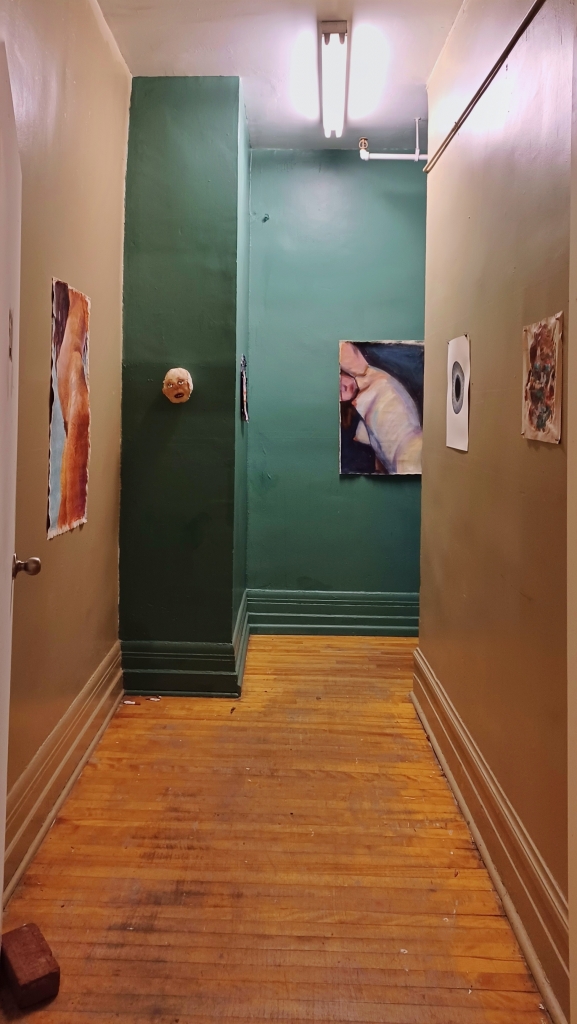
When you enter It is the Closest We Will Be, you start with a mix of new and old, prints, paintings, and two fibre works, on the whimsically-painted early 20th century walls. The choices make more sense as you take in the entire exhibition. To our left, we see the distended torso of a woman with long brown hair hanging in tendrils like Medusa’s snakes, a fragment of the artist. We cannot see her face, but this oil and oil pastel painting’s title, Disease or Desire, asks the question most on the viewer’s mind. Golden Tooth, Beaded Eyes a stuffed and beaded textile piece that looks like a mask almost seems to mock or threaten us as we approach, like a gargoyle warding off those who may not appreciate the show with its bared beaded teeth and beady eyes. On the walls of the hallway leading to the main exhibition room, we see two more fresh oil paintings from this year. Curved, in cool violet, blue, and lemon yellow, is a self-portrait nude torso that shows a body that seems to bend in a stretch, or perhaps just an odd position as she uses the selfie camera on her phone. Also pinned up in the hall is a painting of the arm of the artist’s father painted lovingly and softly against the luminous folds of a pink duvet. The works in this transitional space set the mood for self-reflection and family history. A bright abstract acrylic skin shows us that things are about to get weird.
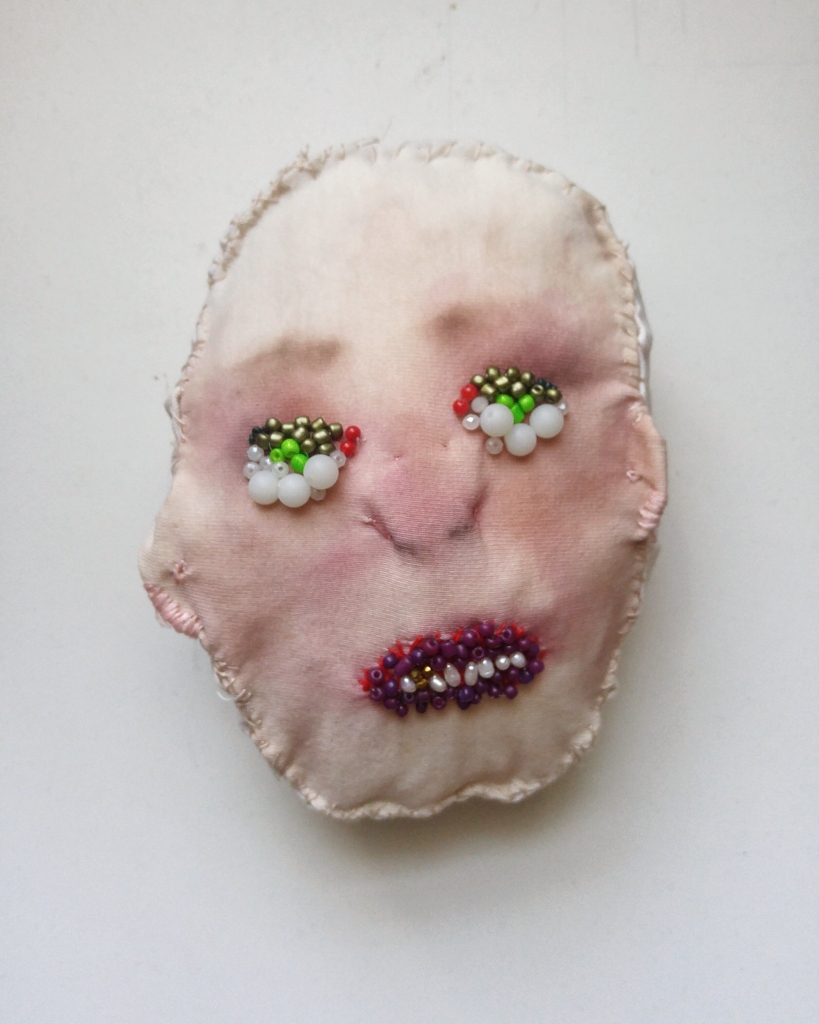
Entering the unconventional main exhibition space, the viewer is probably unsure whether they are intruding upon a private studio, as there is an odd combination of coloured walls, paintings on the wall, odd works scattered about, furniture, and objects which are not normally seen in an art gallery. In the corner to the right of the entrance is an artist’s working station. On a drawing table are a sketchbook, a few art supplies, and a papier mâché Opus card that would definitely not get you a ride. Upon closer inspection we find a lumpy paper cup with questionable ability to hold a drink, and a papier mâché painted apple core, surprisingly detailed, evoking an image of the artist having just left off sketching and snacking. Set up near the work station are a bra with detailed eyes, both seductive and creepy with beaded eye-whites. You can imagine a needle piercing the eye again and again, and lower eye lashes dangle strangely. Above this bra, as if just stripped out of it, are pearlescent white papier mâché sculptures of the artist’s champagne glass breasts. Kitty-corner to those works is the shape of Sokolovskaya’s belly, and above it, gold-tipped breasts.
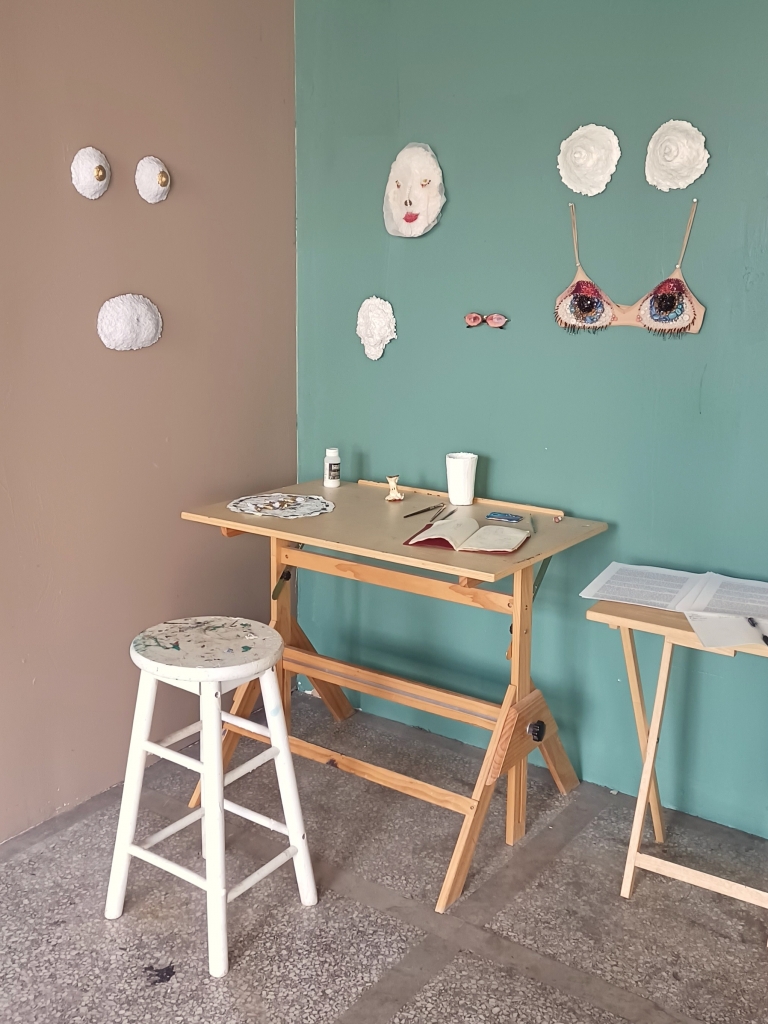
Attention grabbing works a bit further into the space are the bright acrylic skins hanging near the middle of the gallery that are made to look like human skins. They are both funny and grotesque, draped over coat hangers suspended on a closet bar, as if the dotted paint garments are the artist’s human self waiting to be put on. The skin, our largest organ, allows us to feel, to touch and be touched, and to a figurative painter, the skin is so important. The way human skin looks in different light, the way it can reveal our inner workings, our muscles and bones underneath, the ripple of cellulite, the pulse of blood, our fragility, our textures. To paint skin well is to have mastered one of the most difficult things there is to paint.
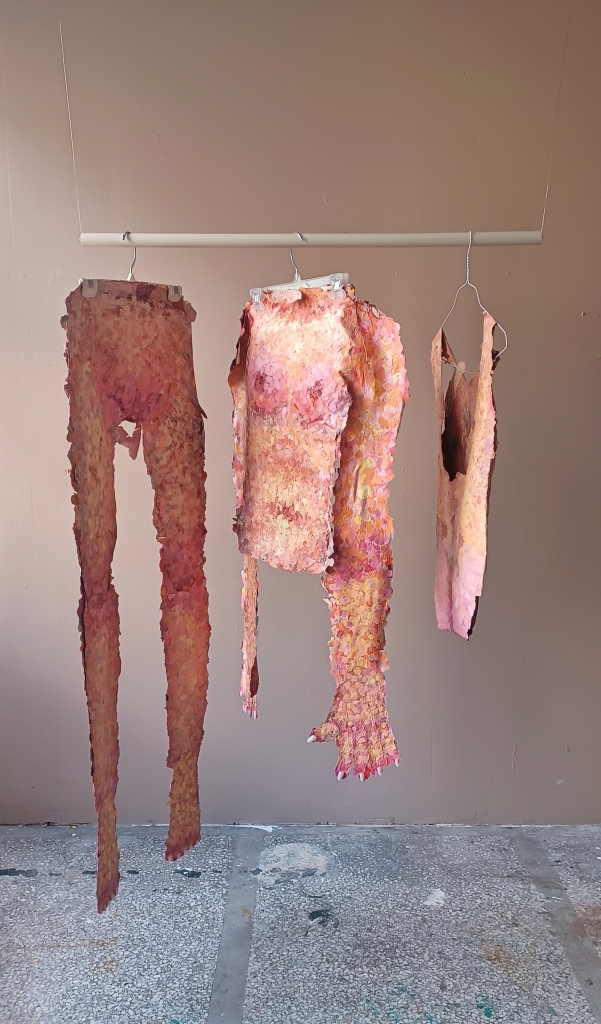
Pinned unstretched on the wall near the skins are oil paintings of Sokolovskaya’s lover posing with them. It is a bit meta, since the acrylic skins are rendered in a painterly, almost pointillist or pixelated way, and then we have two paintings from this year of the skins posed with real humans. In My Bed, shows lovers’ legs stick out from under the bed covers along with the feet of her acrylic skin. It makes me think of someone sitting with the memory of a person who is about to fade away, vanish into little dots of colour. These paintings show intimate scenes, that are a bit comical and also sad in a way. They remind me of how we sometimes cling to outworn relationships, to who we thought our lovers were, to the memory of them. On the other canvas, Your Arm, Sokolovskaya’s lover’s arm is embracing the skin of her body left behind, as if she shed it like a snake and he remains in bed with what is left of her. The human experience is inherently tied up with mortality, with wear and tear, with love and loss. Sokolovskaya touches upon this with quirky curiosity and a touch of existentialism. The unstretched canvases themselves speak to the transitory nature of the artist’s relationship between New York and Montreal. They were rolled and put in her luggage and brought on the train from city to city.
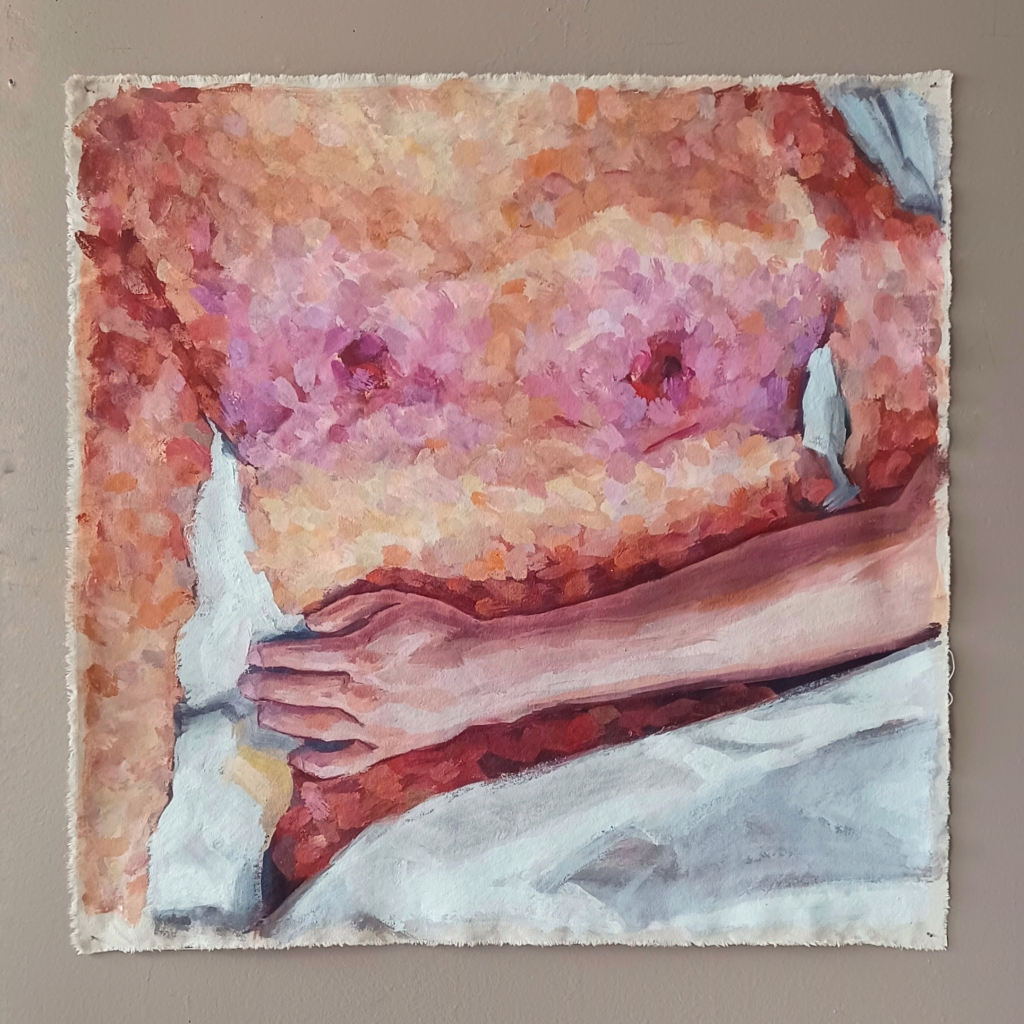
In painting, Sokolovskaya often makes portraits, painting models in class, friends, and most typically, herself. She is interested in moments that are unposed, unusual, funny, and even unflattering. Conventional beauty is not a primary interest to her in making work, and she even explores what many would call ugliness, and yet her work is often beautiful because of her skill with light, colour, and her ability to seemingly effortlessly render skin, bone, and body through a series of dynamic, rapid, yet keenly observed brushstrokes.
Perusing the show feels as if you are creeping in voyeuristically on a private space of the artist in an intimate moment. The ghost of Sokolovskaya—painted loosely on a clear curtain— showers nude in a corner, while on the bed a slice of New York margarita pizza waits for her. Blue-rimmed bowls from her childhood in Uzbekistan and round, hearty Uzbek bread are memories waiting to comfort her, while on the futon bed is a Tarot spread of three cards perhaps indicating a question about the future. The thick cards, the Tower, the Fool, and the Magician, set the tone for change and upheaval, with a touch of hope. The cigarettes which discretely fill the space, in corners, on the sheets, in a bowl, suggest the persistence of a habit, or anxiety. The butts glow with life, skillfully painted, they seem hot and flammable. Some are long with ashes, and some are even gold, as if they are fantasy cigarettes. Sunny side up eggs are scattered around on paper plates, and even loose on a shelf, making the place appear both strange and lived-in. Are these dreams of eggs? Who is this messy, hungry person?
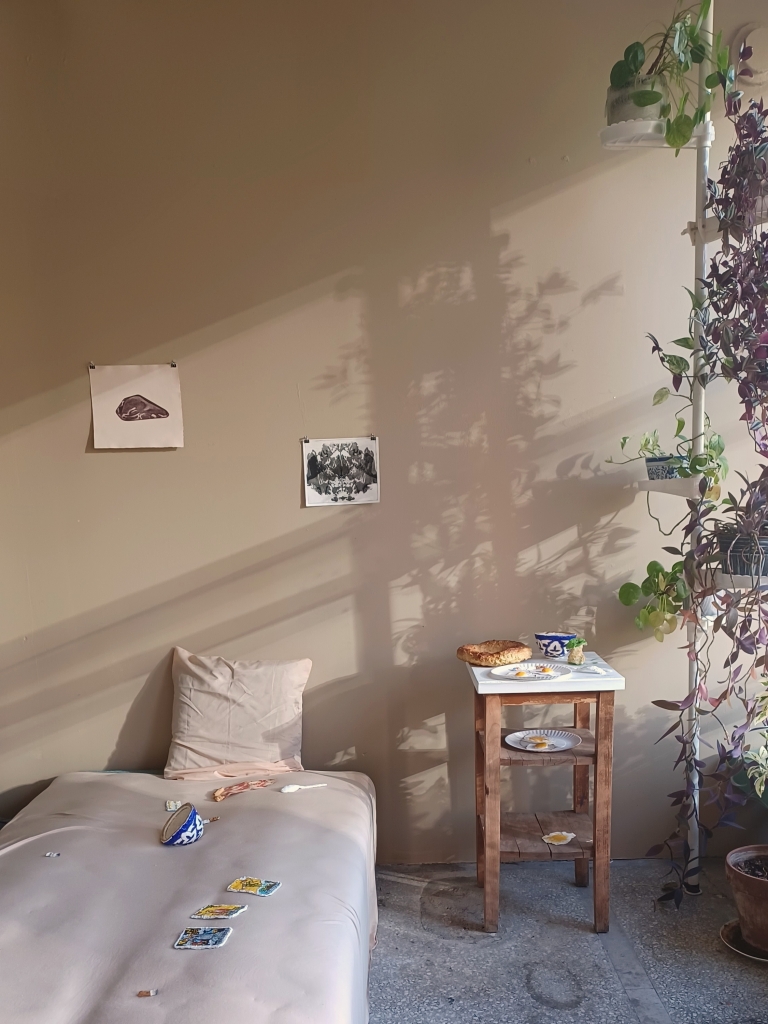
We find her painted loosely in the corner on the shower curtain, a nude brunette, soaping her pits. Acrylic skins of a one-piece bathing suit and bra and panties hang beside. Perhaps the artist is showering paint from her body, or returning from the pool, and will get dressed afterwards, have a cigarette, and think about her next painting while eating her slice of pizza or finishing her eggs. On the bed we find an acrylic skin of a sock that looks like it could have come out of a Phillip Guston painting. Papier mâché Opus and Metro cards make it especially clear the on-the-ground relationship to both cities Sokolovskaya has, and they are strikingly accurate, but also cartoon-like, somehow, in the way they are rough and thick, the opposite of what the sleek familiar cards are. The most erotic painting in the show, Red Body, is an oil painting tacked up by the shower, a pink torso of Sokolovskaya done from a steep perspective that calls to mind nudes one might send to a lover late at night, as seemingly huge fingers graze the bare surface of her pubic mound and her breasts fade off into darkness. The image is faceless.

There is a zest for life here, a hope for the future, and a nostalgia for the past, what could have been, what was and what wasn’t. The works call to mind the way that memory functions, they are wobbly, melting away in a moment. Memories are not as clear from year to year, and eventually they become memories of memories, cartoon-like. Sokolovskaya’s first solo show is a synthesis of everything that came before, and a promise for what is to come, when she returns to Montreal—as this exhibition foreshadowed—to live and work. As in Joseph Campbell’s Hero’s Journey, however, she doesn’t return empty-handed. She returns with new knowledge, new skills, new relationships, and the drive to create new works. She also returns with the aim to create community, which she has been doing for a few years now with her Artist Confluence project that she is bringing to Montreal.
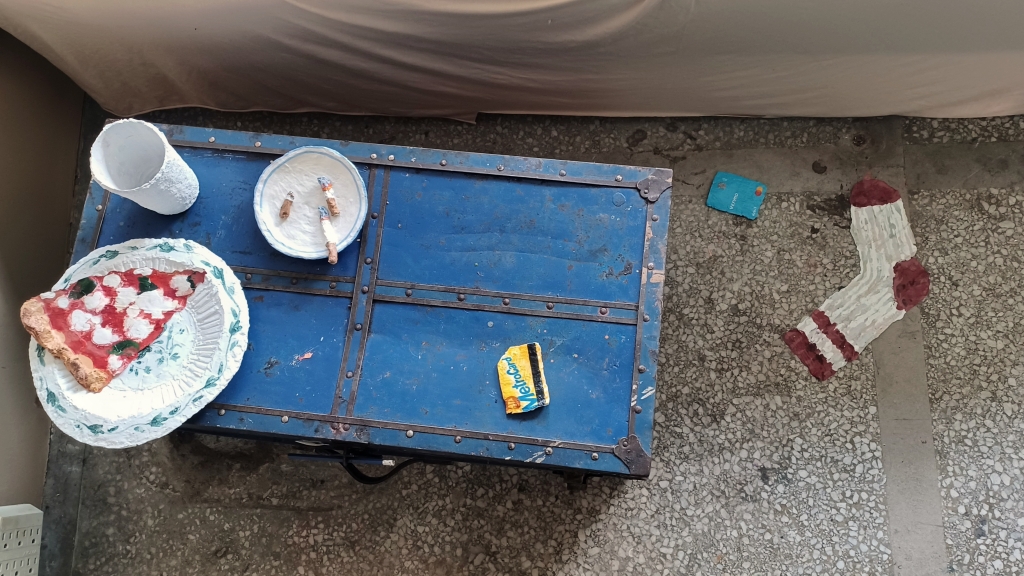
It is the Closest We Will Be is a strong first show from an artist keenly interested in personal reflection, materiality, and experimentation. Deeply considered and finely executed, the works in this show don’t take themselves too seriously. Sokolovskaya seems to have an innate understanding that life is best felt deeply and lived lightly. To do being human well is to be powerfully present while remaining skilled at all the release and letting go that necessitate the mortal experience. In this installation there is a fascination with the self that is the pursuit of many figurative painters, especially young ones—the questions “Who am I? Where have I come from? Where am I going? Why am I here? Can I make others understand me?” arise from all deep thinkers and feelers. But beyond the personal, there is also a fascination for what it means to be human, what it means to deeply inquire, to deeply seek to understand and interpret one’s own human journey, which, although unique, is an experience we all share.


